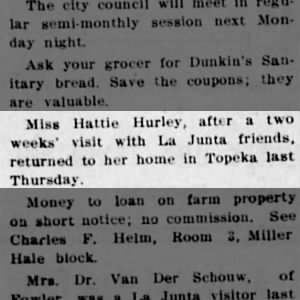
La Junta Tribune Archive
- La Junta, Colorado
- 1898–1917
About
The La Junta Tribune of La Junta, Colorado, began publication in 1881 or 1882. The exact date is unknown, as the only remaining copy of its first issue has long since disappeared. The founder of the paper, J.C. Denny, besides being the proprietor and editor, was also the station agent, telegraph operator, attorney-at-law, and the first mayor of the small railroad town situated along the Atchison Topeka and Santa Fe lines in Otero County. Denny began publishing the weeklyTribune on an old army printing press in a former Santa Fe Railroad freight depot. The paper was briefly suspended in 1882, but by 1883 it was being published by Editor Nelson H. Bowman. The latter took charge of the Tribune at the insistence of T.J. Hickman and J.C. Jones, who held the mortgage on the paper, for the purpose of boosting Hickman and his friends into political office. Bowman expanded the Tribune's plant and continued as publisher until 1886.
The La Junta Tribune of La Junta, Colorado, began publication in 1881 or 1882. The exact date is unknown, as the only remaining copy of its first issue has long since disappeared. The founder of the paper, J.C. Denny, besides being the proprietor and editor, was also the station agent, telegraph operator, attorney-at-law, and the first mayor of the small railroad town situated along the Atchison Topeka and Santa Fe lines in Otero County. Denny began publishing the weeklyTribune on an old army printing press in a former Santa Fe Railroad freight depot. The paper was briefly suspended in 1882, but by 1883 it was being published by Editor Nelson H. Bowman. The latter took charge of the Tribune at the insistence of T.J. Hickman and J.C. Jones, who held the mortgage on the paper, for the purpose of boosting Hickman and his friends into political office. Bowman expanded the Tribune's plant and continued as publisher until 1886.
In that year, G.D. Phillips purchased the paper, material, and subscription list for $1200. Boosterism was the tone of the Tribune under Phillips, who "never missed an opportunity to set forth the natural advantages of the Arkansas valley, its fertile soil, irrigation resources, abundant sunshine and pure air...and its comparative freedom from destructive storms and cyclones." In April 1887, the paper was sold to A.J. Johnson and W.S. English, but by June 1888, Phillips repurchased his interest from Johnson and Phillips and English acted as co-editors. Throughout the early 1890s, ownership and editorship of the Tribune transferred back and forth between Phillips, English, George S. Thomson, and J. F. Thompson. In December 1894, A.T. Hunt purchased the paper, later selling it to C.D. Parks. Frederick Bane Mason purchased an interest in the Tribune, and for a time the paper published under the name of Parks & Mason. Parks sold his share to H.L. Brown, after which paper was published under Brown & Mason. About the many managerial changes, the paper noted "there seems to have been an inclination on the part of the Tribune's editors to seek more congenial climes or occupations. In fact there were times when they came and went with a facility almost equalling some of our western 'boom towns.'" Frederick Banes Mason, however, remained editor and proprietor (having bought out Brown in 1900) until his death in 1928.
From its beginning, Tribune supported Republican politics and politicians, both local and national, and was an ardent proponent of female suffrage in Colorado, which was legislated in 1893. The Tribune's first editor, J.C. Denny, noted that paper was kept alive by the patronage of the railroad boys and stockbrands. Early on, the Tribune enjoyed considerable financial support from the livestock industry, publishing a brand book and map and obtaining associated advertising revenue. However, because the Tribune advocated for the building of irrigation ditches and supported homesteading in general, which led to the tearing down of ranchers' wire fences, the stockmen retaliated by taking their brands out of the paper and cutting the Tribune from their lists. The struggling newspaper was only kept afloat by deals involving political endorsements and individual donations.
By the time J.F. Thompson took over as editor, the Tribune was in severe financial straits. The enterprising Thompson rode out to an impressive ranch intending to write up the spread for the Tribune. The owner happily accommodated Thompson's request and displayed his ranch and stock. A lengthy article appeared in the next issue of the paper, describing the ranch in glowing terms. Colorado Newspapers: A History & Inventory, 1859-2000 (Jane C. Harper, Craig W. Leavitt, and Thomas J. Noel) mentions that Thompson subsequently mailed the rancher a copy of the article along with a bill for $250, which the rancher gratefully paid. The La Junta Tribune continued until 1938 when it merged with La Junta Daily Democrat. In 1944, the paper was renamed the La Junta Tribune-Democrat.
Archive Info
- 9,235
- La Junta, Colorado
- 1898–1917
Source Information
La Junta Tribune, 1898–1917 [database on-line]. Lehi, UT, USA: Ancestry.com Operations, Inc., 2024. Last updated: August 19, 2022
Recent Article Clippings
See All
Hattie Hurley and Harry arrive in La Junta from Topeka to visit with friends.
La Junta Tribune
Mrs. D Hurley & Hattie travel to funeral of Mrs. Hurleys brother.
La Junta Tribune
J E Hurley superintendent of the Santa Fe system in town for meeting. (Hattie's uncle)
La Junta Tribune
Hattie Hurley returns home to Topeka after two weeks visit with friends.
La Junta Tribune
Hattie Hurley leaves La Junta for Topeka after several weeks visit.
La Junta Tribune
